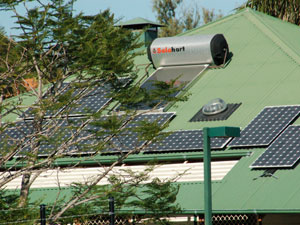Arno's EnergyIdeas (16)
About hydrogen and fuel cells in Australia
The 17th World Hydrogen Energy Conference (WHEC) in Brisbane,
Queensland, Australia in June 2008 (the 18th WHEC, will be held 16 to 21 May 2010
in Essen, Germany) was a good opportunity, to do a littele research about hydrogen and fuel-cell activities "down under".

Eureka! One of the few buildings in Brisbane with solarthermic and photovoltaic systems on its roof. Photo: Arno A. Evers, Arno A. Evers FAIR-PR |
In Australia there are, according to the study: "Towards development of
an Australian scientific roadmap for the hydrogen economy" (published in
March 2008 and based on the results of the symposium "Science on the way
to a hydrogen economy" from 05 May 2006) six commercial companies in Australia: "... with an interest in hydrogen technologies ...". These are:
Ceramic Fuel Cells Limited (CFCL), www.cfcl.com (since 2004 exhibitors
at the joint stand hydrogen and fuel cells at the annual Hannover Fair);
Eden Energy Ld, www.energy.com.au; Oreion Australian Energy Pty Ltd,
www. oreion.net; Wind Hydrogen Ltd, www.wind-hydrogen.com; Hydrogen
Technology Limited, www.hydrogentechnology.com.au and Hydrexia Pty Ltd
www.hydrexia.com.au
According to my knowledge, only one company at the 17th WHEC was
exhibiting: Eden Energy Ltd., however, at least that they had "Booth Number
1". For the other Australian hydroigen related companies this event was probably not
interesting enough.
Returning to the above-mentioned study:
Here we find familiar information: Hydrogen could deliver: "... significant contributions to be used as fuel for transport and electricity demand in Australia and
at international level…". The "... special attractiveness "of hydrogen would be in its capacity as a clean energy source ("... ...") for fuel cells. Here the scientists have probably overlooked, that someone (whoever) has to produce hydrogen first. Hydrogen is not a source of energy and never will be one. It is only an ergy carrier.
Furthermore, we learn: "... There are a number of hydrogen-fuel cell prototypes (also a" treacherous "formula, because there is a number of other than hydrogen fuel cells existing) in test and field trials for both stationary and automotive applications, but significant scientific, technical and economic challenges must be solved before hydrogen can become a widespread alternative energy in the next 20 to 50 years ... ". That is good to know and extremely motivating.
But the "challenges" are also known by the authors of the study:
- large-scale production of hydrogen from coal and natural gas together with
CO 2 sequestration, up
to the time when hydrogen from renewable sources could be obtained economically
- Infrastructure for hydrogen filling stations and delivery systems;
- improved technologies for hydrogen storage;
- fuel cells with improved reliability and lower cost and
- Standards for the safe handling of hydrogen and public
safety ... "
All of this we have once heard somewhere before, the study continues:
"... The different national priorities for hydrogen energy research and
development depend on the relative dependence of the country from
other energy sources, especially fossil fuels, strategies to ensure
supply security and to combat climate change by reducing emissions from greenhouse gas ...". Ah, yes.
Further quotes: ".... Australia enjoys relatively low cost structures in
electricity production for the domestic industry and the requirements
were based largely on the large domestic reserves of coal and natural
gas. It is therefore not surprising that early initiatives of federal
and state government in areas such as the efficient use of coal and gas,
but there is also support for the development of alternative renewable
energy sources such as wind, solar, and geothermal energy ... "
Enough of the report, back to reality: the list of CO2 production countries per capita
considers Australia at a proud 13rd place of 206 countries studied (for comparison: Germany: 38, France 63, China: 91, India: 133 place)
When asked about the active application of solar energy we heard: "We had tried, however, it has not achieved anything. Sometimes the sky is overcast for ten days and we have no storage technologies. The "personal research" alongside the Sydney-Brisbane route confirmed it: In eastern Australia there are little solarthermic or photovoltaic systems, you are pleased about each individual system you meet, though.
To the Australian science and industry, I would like to address: "All the very best in implementing the structure of the Australian hydrogen economy!"
Links to the News:
Symposium: „Science on the way to a hydrogen economy“
http://www.science.org.au/sats2006/symposium.htm
Studie:“Towards development of an Australian scientific roadmap for the hydrogen economy“
http://www.science.org.au/reports/hydrogen.pdf
Co2 Produktion pro Kopf und Land
http://en.wikipedia.org/wiki/List_of_countries_by_carbon_dioxide_emissions_per_capita
Internetdokumentation zur 17. WHEC in Brisbane, Australien
https://www.hydrogenambassadors.com/meet-aae/whec2008/index.php
Date: 01.07.2008 |
